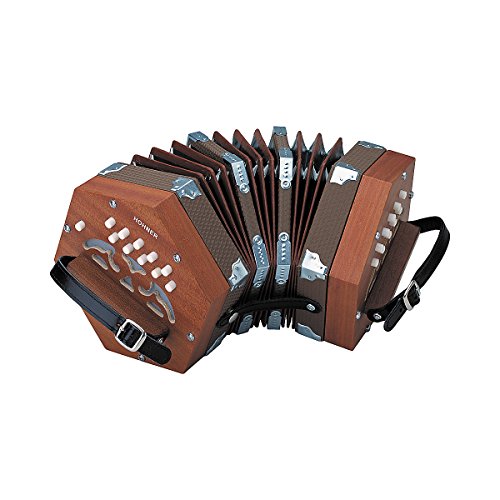
Different Types of Concertina
Concertinas are free-reed musical instruments similar to an accordion; however, their body shape differs considerably and are usually smaller.
A concertina consists of two panels joined together by bellows. On both ends, there are buttons for notes that can be pressed with one hand to create complex melodies and chords.
English
William Wheatstone designed the English Concertina as a fully chromatic instrument featuring two center rows on either side, in C key, with all sharps and flats divided amongst outside rows to enable players to play all required chromatic notes for complete scale by alternating left and right hands.
However, this can also make playing melodies with low accompaniment (ragtime for example) somewhat restricted as its range of notes may be restricted compared to other concertinas – hence why some have additional keys in the high treble section.
Some individuals opt for an Anglo concertina over its English counterpart because it can accommodate different genres of music more effectively, including Irish, folk and classical.
German
Concertinas are hand-held bellows-driven free reed instruments with buttons (keys) that produce sound through changes in air pressure, making it popular instruments in classical and folk music of Ireland, England and South Africa as well as for tango and polka.
Concertina Accordion come in various styles, all sharing the basic design of folding bellows with buttons at either end and 6-12 sides in cross section. Their variations differ by keyboard layout and whether individual buttons produce the same (unisonoric) or different (bisonoric) notes when air pressure changes direction.
Anglo-German concertinas, commonly known as English or Irish concertinas, are by far the most prevalent system. It originated as an offshoot of Uhlig’s original 20-button German concertina designed in 1834; soon after its creation it quickly gained popularity throughout England, Ireland, and North America.
Franglo
Concertinas come in many varieties and each varies in its keyboard layout and tone production (whether similar notes are produced when air pressure shifts in one direction vs another) along with how they are played.
Early concertinas, commonly referred to as English concertinas, were fully chromatic instruments with two rows on either side and typically played in C as their key of origin.
They are widely used for playing classical music, traditional Irish and English tunes, tango, polka and other Eastern European forms of popular music, solo singing or with chorus performances; playing either plectrum-free or hand position is possible.
German concertinas became widely imported during the 1840s to England and North America, although early English manufacturers weren’t keen on using its 20-button system; early English manufacturers believed it too costly and unattractive for use. Over time, English manufacturers made adjustments to suit their own needs, becoming the Anglo or Anglo-German.
Folding
Concertinas are free reed instruments characterized by expanding and contracting bellows with buttons (or keys) at both ends that push air through reeds to produce notes. Concertinas can be played one note at a time or can even be learned to produce chords and octaves of notes simultaneously.
Concertinas come in many varieties. All share the basic design of folding bellows connected by buttons at either end, yet each differs greatly in layout and function.
Jeffries system makes sounds by pushing and pulling, while Wheatstone system features buttons arranged differently on its right-hand side, which contributes to different notes being produced in each system.